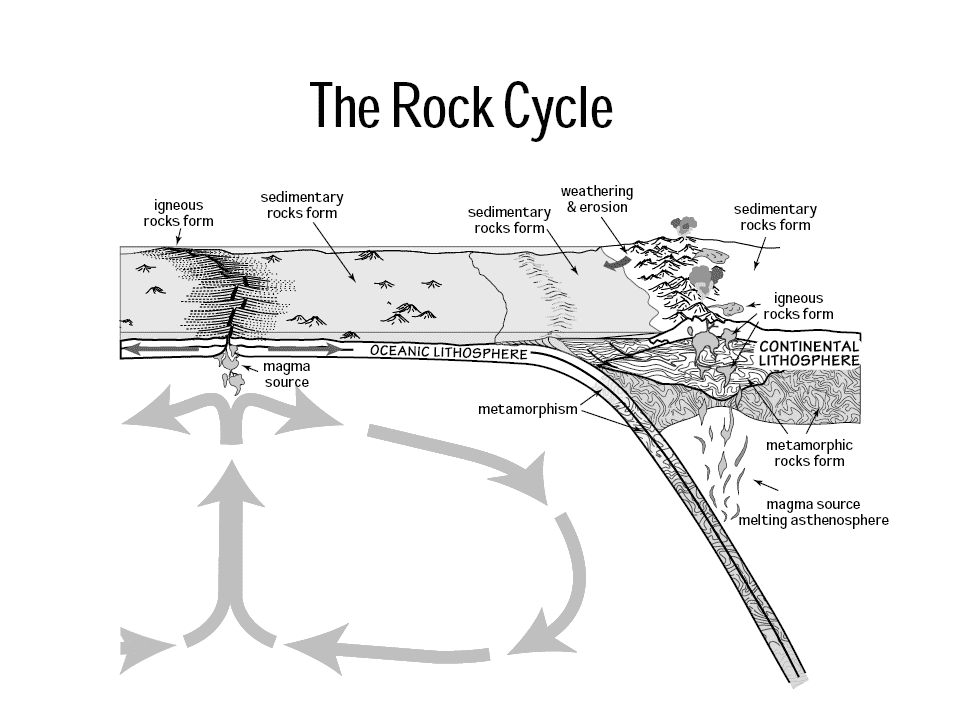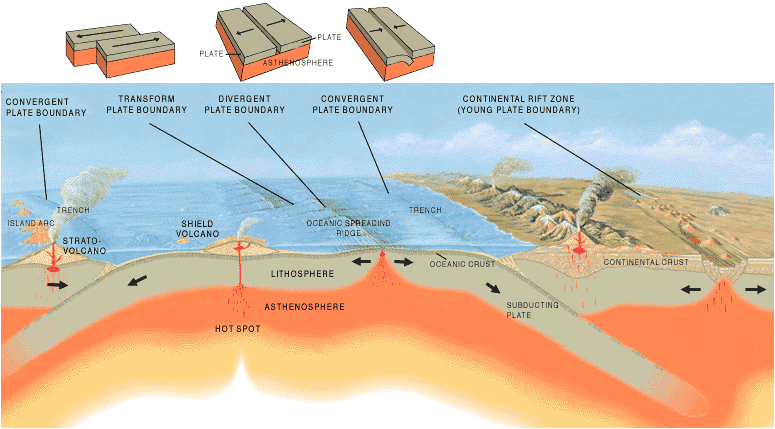What is the rock cycle?
The rock cycle is a set of changes that describes the processes through which igneous, metamorphic, and sedimentary rocks transform into one another.

We might think rocks are rigid and unchangeable, but at a geological scale, nothing is stable and everything changes. Due to the moving tectonic plates, which act as a driving force, rocks are subjected to a range of transforming processes. If the conditions are right, igneous rocks can transform into sedimentary or metamorphic, metamorphic rocks can become igneous or sedimentary, and sedimentary (you’ve guessed it!) can also transform into igneous or metamorphic.
The first description of this study is usually attributed to James Hutton, a renowned geologist from the 18th century. Hutton described it in a way that is largely accepted to this day — a cyclical, non-repeating, neverending cycle. No vestige of a beginning, and no prospect of an end, Hutton is credited as saying. Rocks are constantly being pushed around, submerged, uplifted, molten, cooled, and re-cooled, it truly is an endless process.
To an extent, you can think of it as an analog to the water cycle, though the two share very few practical similarities. Still, like the water cycle, the rock cycle is crucial to all environments. Let’s have a more detailed look and see how it takes place.
The types of rock
In order to understand what happens in the rock cycle, we need to understand its basic elements: rocks. There are three main types of rocks: igneous, metamorphic, and sedimentary. Let’s take it from the bottom to the top.
Igneous rocks
Igneous (sometimes called magmatic) rocks are formed through the cooling and solidification of magma. The magma is very hot (and melted), but as it rises towards the surface, it starts to cool down. If it cools down slowly, it will feature large crystals, but if it cools down fast, it will have smaller, sometimes microscopic crystals. In the case of some volcano eruptions where they cool off very fast, they can also bypass crystals completely and appear in the form of glass.
The formation of igneous rocks is tightly connected to melting temperatures. The word igneous is derived from the Latin word ignis meaning fire.
Metamorphic rocks
Metamorphic rocks are formed whenever you take an initial rock and subject it to high temperatures and/or pressures so that some of the rock’s fundamental properties change. They can form from tectonic processes such as continental collisions, as well as from other, more low-scale processes. Sometimes, either the pressure or the temperature can be the dominant process, resulting in specific structures and textures of the rock. But if the temperature is too high, it can turn into an igneous rock instead of a metamorphic rock.
The formation of metamorphic rocks is tightly connected to changes in temperature and pressure. The word metamorphism means ‘change of form’.
Sedimentary rocks

Sedimentary rocks are formed through the deposition and cementation of sediment. Sediment refers to any type of geological or biological particle small enough to be transported by forces such as wind or water. Sediment can be formed through any number of processes such as erosion or weathering and can be transported in any number of ways — as long as it is deposited into a unitary form, it can develop into sedimentary rock.
While igneous and metamorphic rocks form deep beneath the surface, sedimentary rocks can form at the surface or in shallowly buried environments.
The Rock cycle transitions
As we mentioned above, any type of rock can turn into any type of rock under the right geological circumstances. By now, you might already have some idea about how the transitions work, so let’s break it down. We’ll start with the transitions, and then discuss the processes which cause these transitions.
Transition to igneous rocks
In order for a rock, whether sedimentary or metamorphic, to turn igneous, it must first get hot; really hot. I mean melt-it-in-magma hot. Geologically, the way you do is you start burying it, more and more, deeper and deeper. At one point, it starts melting into magma, and then, it’s all set to cool down — only this time, as an igneous rock. Of course, this process takes a very long time, up to millions of years. By the time it cools down, you can’t really say it’s the same rock as it started, having melted and diffused in the magma.
Transition to metamorphic rocks
Again, it doesn’t matter what the original rock starts as. All you need to do is subject it to temperature and pressure. How do you do it? Again, you bury it. You don’t want to melt it though — you just want to raise the temperature and pressure enough for physical and chemical changes. You can have contact metamorphism, where a mass of rock gets in contact with or very close to a hot igneous mass of rock. This alters and recrystallizes the rock. You can also have regional metamorphism, which often indicates a mountain formation area, and in this case, rocks are often foliated. Either way, the process ensures dramatic changes in the rock and once more, you don’t end up with the same rock as the one you started with.
Transition to sedimentary rocks
Alas, not all rocks stay in the “cozy” and “warm” depths — some are pushed toward the surface. Rocks don’t really enjoy the surface. They’re subject to weathering, precipitation, and wind, it’s a nasty world if you’re a rock. So they start to break down. The resulting sediment is transported and can start to accumulate. However, there’s a big difference here: in many instances, you can identify what the original rock was, since most changes are physical and not chemical.
The driving processes
The rock cycle, and geology itself, are triggered by movement. Things are uplifted and subducted, pushed around in all directions. We don’t realize this because geologic processes happen on a scale of millions of years. To us, geology seems static. But at a planetary scale, geology is quite dynamic. These are the main processes that drive it.
Plate tectonics
It might seem counterintuitive to say things like “pushing rocks downwards” or “mountain formation” — how does that even work? Well, the crust of the Earth, the entire world as we see it, is split into several rigid plates, called tectonic plates. These plates lie on top of the mantle and are moving relative to each other, at an order of a few centimeters per year. It might not seem like much, but this is the principal acting force in geology. Almost everything that happens in geology, especially the rock cycle, can be traced back to plate tectonics. They can slide by each other, subduct, or uplift. Subduction is specifically important to the rock cycle, as it is a way to “recycle” rock — bring it down to the mantle, where it is melted and can take a new shape.
Spreading ridges
You can imagine, that if at one part of the Earth, two tectonic plates are crashing against each other, then somewhere else, they are pulling away from each other. This is where new magma is produced, relatively close to the surface. This creates both igneous and metamorphic rocks in the area. This is also a consequence of plate tectonics.
Weathering
It’s not just deeper processes, surface processes affect the rock cycle too. Remember: igneous and metamorphic rocks always form in the depths, and sedimentary rocks can form at the surface.
The rock cycle is complex
It’s important to keep in mind that this is just a simplification, the rock cycle is immensely complex, continuously affecting all rocks, from the surface to the depths of the Earth. It is not a single, unitary process, but rather a sum of processes, each of which in turn cascades into other processes. This should give you a pretty good idea of the general concepts involved.









